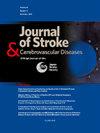Enlarged perivascular spaces and clinical outcome of acute ischemic stroke patients receiving intravenous thrombolysis
IF 2
4区 医学
Q3 NEUROSCIENCES
Journal of Stroke & Cerebrovascular Diseases
Pub Date : 2025-05-07
DOI:10.1016/j.jstrokecerebrovasdis.2025.108342
引用次数: 0
Abstract
Background
Enlarged perivascular spaces (EPVS) is one of the main imaging features of cerebral small vessel disease (CSVD). Previous studies have shown that hypertension and advanced age were important risk factors for the occurrence and development of EPVS. We aim to explore the correlation between the severity of EPVS at centrum semiovale and basal ganglia and the early and long-term outcome of acute ischemic stroke (AIS) patients receiving intravenous thrombolysis.
Methods
AIS who received intravenous thrombolysis at the First Affiliated Hospital of Kunming Medical University were retrospectively collected. Demographic data, stroke risk factors, laboratory test results and head imaging data were collected. The number of EPVS in centrum semiovale and basal ganglia of patients in cranial magnetic resonance imaging (MRI) was counted by visual quantification method. Logistic regression analysis was used to evaluate the independent risk factors affecting the prognosis.
Results
A total of 196 subjects were included in this study. The proportion of patients with poor clinical outcome at 90 days was higher in patients with moderate-to-severe centrum semiovale EPVS than in those with no-to-mild EPVS (42.9 % vs 18.7 %, P=0.031). Similarly, patients with moderate-to-severe EPVS in the basal ganglia region had a significantly poor clinical outcome at 90 days (51.7 % vs 18.3 %, P=0.001). Moderate to severe basal ganglia EPVS (OR=2.661, 95 %CI: 1.070-6.618, P=0.035), hyperlipidemia (OR=3.011, 95 %CI: 1.147-7.902, P=0.025) and a higher baseline NIHSS score before thrombolysis (OR=1.194, 95 %CI: 1.071-1.331, P=0.001) were independent risk factors for poor clinical outcome at 90 days. Early neurological improvement (OR=0.220, 95 %CI 0.093-0.520, P=0.001) was associated with a reduced risk of poor clinical outcomes at 90 days.
Conclusions
Moderate-to-severe EPVS in basal ganglia were an independent risk factor for poor clinical outcome at 90 days in AIS patients with intravenous thrombolysis. Therefore, the severity of EPVS in the basal ganglia region can serve as an imaging marker to predict the 90-day clinical outcome of AIS patients treated with intravenous thrombolysis.
静脉溶栓治疗急性缺血性脑卒中患者血管周围间隙增大与临床预后
背景血管周围间隙增大(EPVS)是脑血管病(CSVD)的主要影像学特征之一。既往研究表明,高血压和高龄是EPVS发生发展的重要危险因素。我们的目的是探讨半瓣膜区和基底神经节EPVS的严重程度与急性缺血性卒中(AIS)患者接受静脉溶栓治疗的早期和长期预后之间的相关性。方法对昆明医科大学第一附属医院静脉溶栓患者进行回顾性分析。收集人口统计资料、卒中危险因素、实验室检查结果和头部成像数据。采用目视量化方法,对颅脑磁共振成像(MRI)患者半瓣膜中央和基底节区EPVS数量进行计数。采用Logistic回归分析评价影响预后的独立危险因素。结果本研究共纳入196名受试者。中度至重度半瓣膜体EPVS患者90天临床预后不良的比例高于无至轻度EPVS患者(42.9% vs 18.7%, P=0.031)。同样,基底节区中重度EPVS患者在90天的临床结果明显较差(51.7% vs 18.3%, P=0.001)。中重度基底神经节EPVS (OR=2.661, 95% CI: 1.070 ~ 6.618, P=0.035)、高脂血症(OR=3.011, 95% CI: 1.147 ~ 7.902, P=0.025)和溶栓前NIHSS基线评分较高(OR=1.194, 95% CI: 1.071 ~ 1.331, P=0.001)是90天临床预后不良的独立危险因素。早期神经系统改善(OR=0.220, 95% CI 0.093-0.520, P=0.001)与90天不良临床结果风险降低相关。结论中重度基底神经节EPVS是静脉溶栓治疗AIS患者90天临床预后不良的独立危险因素。因此基底节区EPVS的严重程度可作为预测AIS患者静脉溶栓治疗90天临床预后的影像学指标。
本文章由计算机程序翻译,如有差异,请以英文原文为准。
求助全文
约1分钟内获得全文
求助全文
来源期刊

Journal of Stroke & Cerebrovascular Diseases
Medicine-Surgery
CiteScore
5.00
自引率
4.00%
发文量
583
审稿时长
62 days
期刊介绍:
The Journal of Stroke & Cerebrovascular Diseases publishes original papers on basic and clinical science related to the fields of stroke and cerebrovascular diseases. The Journal also features review articles, controversies, methods and technical notes, selected case reports and other original articles of special nature. Its editorial mission is to focus on prevention and repair of cerebrovascular disease. Clinical papers emphasize medical and surgical aspects of stroke, clinical trials and design, epidemiology, stroke care delivery systems and outcomes, imaging sciences and rehabilitation of stroke. The Journal will be of special interest to specialists involved in caring for patients with cerebrovascular disease, including neurologists, neurosurgeons and cardiologists.
 求助内容:
求助内容: 应助结果提醒方式:
应助结果提醒方式:


